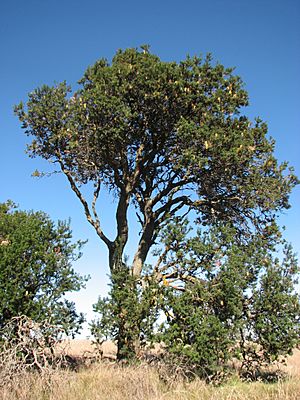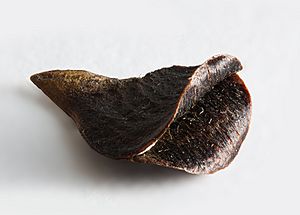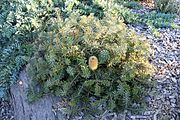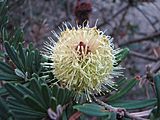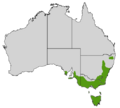Silver banksia facts for kids
Quick facts for kids Silver banksia |
|
|---|---|
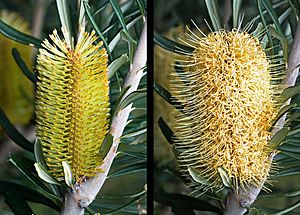 |
|
| Unopened buds (left), opened flowers (right) | |
| Scientific classification | |
| Genus: |
Banksia
|
| Species: |
marginata
|
| Synonyms | |
|
Banksia microstachya Cav. |
|
The silver banksia (Banksia marginata) is a type of tree or woody shrub found across much of southeastern Australia. It grows from the Eyre Peninsula in South Australia all the way to northern Armidale, New South Wales, and also across Tasmania and the islands in Bass Strait. You can find it in many different places, like Eucalyptus forests, scrubland, heathland, and moorland.
The silver banksia can look very different depending on where it grows. It can be a tiny shrub only 20-centimetre (7.9 in) tall or a large tree up to 12-metre (40 ft) high. Its leaves are long and narrow, and its yellow flower spikes (called inflorescences) appear from late summer to early winter. After flowering, these spikes turn brown and then grey. They develop woody seed pods, called follicles, which hold winged seeds.
This plant was first described by Antonio José Cavanilles in 1800. Later, other scientists thought different forms of the plant were separate species. However, in 1870, George Bentham grouped them all together as one species again.
Many birds, especially honeyeaters, visit the flower spikes to find food. Native bees and European honeybees also feed there. The silver banksia reacts differently to bushfires. Some plants are killed by fire but grow back from seeds stored in their cones. These seeds are released after a fire. Other plants can regrow from underground stems called lignotubers or from shoots that grow from their roots. While its wood has been used for timber, the silver banksia is now mostly grown in gardens. Smaller, dwarf types are often grown and sold for this purpose.
Contents
What Does the Silver Banksia Look Like?
The silver banksia is a very varied plant. It can be a small shrub about 1-metre (3.3 ft) tall or a tree up to 12-metre-high (39 ft). Some very tall trees, up to 30-metre (98 ft), have been seen in Victoria and Tasmania. On the other hand, tiny shrubs only 20 cm (7.9 in) high grow in coastal areas of Tasmania.
Its bark is light grey and smooth when young. As the tree gets older, the bark becomes finely cracked, like a puzzle (this is called tessellated). New branches are hairy at first but lose their hairs as they grow. New growth is often a pale or pinkish brown color.
The leaves grow in an alternating pattern on short stalks (called petioles). Young leaves are usually toothed and measure 3–7 cm [1.2–2.8 in] long. Adult leaves are dull green, narrow, and measure 1.5–6 cm (0.6–2.4 in) long and 0.3–1.3 cm (0.1–0.5 in) wide. As they age, the edges of the leaves become smooth. The tip of the leaf is often flat or slightly notched, but can also be pointed. The leaves are a bit stiff and have tiny pores (stomata) that are sunken. The underside of the leaf is white with a clear central vein (midrib) covered in brownish hairs.
Flower Spikes and Seeds
The silver banksia's flower spikes, or inflorescences, usually appear from late summer to early winter (February to June) in New South Wales and Victoria. These spikes are shaped like cylinders, 5–10 cm (2–4 in) tall and 4–6 cm (1.6–2.4 in) wide. They are pale yellow and can have a grey or golden tint when they are still buds. Each spike can have up to 1,000 individual flowers.
Like most banksias, the flowers open from the bottom of the spike upwards. Over time, the flower spikes fade to brown and then grey, and the old flowers usually stay on the cone. Woody seed pods (follicles) grow in the six months after flowering. Up to 150 follicles can grow on one flower spike, but often only a few develop. These small, oval pods measure 0.7–1.7 cm (0.3–0.7 in) long.
In some areas, especially near the coast, these pods open on their own and release seeds. In other places, like heathlands or mountains, they usually stay sealed until a fire burns them. Each pod holds one or two fertile seeds. Between the seeds is a woody, dark brown separator. The seeds are 0.9–1.5 cm (0.4–0.6 in) long and have a dark brown, papery "wing" that helps them fly in the wind.
When a seed sprouts, it first grows two oval-shaped leaves called cotyledons. These first leaves can stay for several months as more leaves appear.
How the Silver Banksia Got Its Name
The silver banksia is called that because the white undersides of its leaves stand out against the green, making the plant look "silvery." Other common names include honeysuckle and dwarf honeysuckle. Aboriginal people had their own names for it, like warock in the Jardwadjali language and pitpauwe in the Kaurna language.
Captain James Cook saw this tree in January 1777 during his third voyage. He described it as a common tree with narrow leaves and a large, yellow, cylindrical flower. The genus Banksia was named after Sir Joseph Banks, a botanist who traveled with Captain Cook on his first voyage.
The species name marginata was given by the Spanish botanist Antonio José Cavanilles in 1800. Marginatus is a Latin word meaning "bordered," which refers to how the white underside of the leaves looks like a border when you view them from below.
Over the years, different scientists gave the silver banksia many different names because it looks so varied. For example, Robert Brown described several forms as separate species in 1810. However, in 1870, George Bentham realized that all these different forms were actually the same species, Banksia marginata. He noted that the features used to tell them apart were not consistent enough.
Where the Silver Banksia Fits in the Plant Family Tree
Today, the way Banksia plants are grouped is based on botanist Alex George's work from 1999. In this system, B. marginata is placed in the subgenus Banksia because its flowers grow in the typical banksia spikes. It's also in the section Banksia because its flower parts are straight, and in the series Salicinae because its flower spikes are cylindrical.
Scientists continue to study the relationships between different banksia species using DNA information. These studies sometimes suggest different ways to group the plants. For example, some research suggests that B. marginata is most closely related to Banksia saxicola.
Here's a simplified look at where B. marginata fits:
- Genus Banksia
* B. dentata * B. aquilonia * B. integrifolia * B. plagiocarpa * B. oblongifolia * B. robur * B. conferta * B. paludosa * B. marginata * B. canei * B. saxicola
Hybrids with Other Banksia Species
Sometimes, Banksia marginata can cross-breed with other banksia species where their habitats overlap. This creates hybrids that have features from both parent plants. For example, hybrids have been found with Banksia conferta and Banksia paludosa. A hybrid with Banksia saxicola was also noted.
There's also a known hybrid with B. integrifolia, which is sometimes grown in gardens. This hybrid forms an attractive, low-growing plant that is quite tough.
Where the Silver Banksia Lives
The silver banksia is found in northern New South Wales, south through Victoria and into South Australia, and all over Tasmania. It also grows on the main islands in Bass Strait. It's quite rare in southwestern New South Wales. In Victoria, it mostly grows near the coast, but in New South Wales, it's not found in coastal areas around Sydney.
This plant can grow in many different types of soil, from clay to sandy or rocky soils. It can also handle a wide range of soil acidity, from very acidic soils to alkaline soils. You can find it from sea level up to 1,200 m (3,900 ft) high in places like Mount Field National Park.
Ecology and Life Cycle
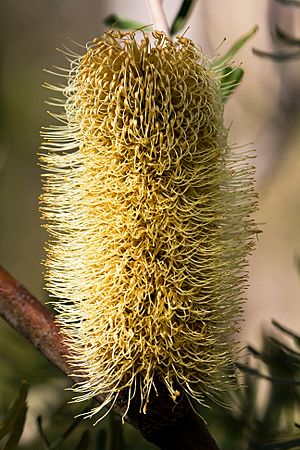
Many animals visit the silver banksia's flowers. Birds like rainbow lorikeets, musk lorikeets, and various honeyeaters feed on the nectar. The yellow-tailed black cockatoo eats the seeds. Small mammals like the agile antechinus and sugar glider also visit the flower spikes. Ants, bees (both native and European), and butterflies are also common visitors.
Some insects can affect the plant. A type of wasp causes galls (unusual growths) on the stems. The banksia longicorn beetle bores holes in the base of the plants, which can weaken them and cause them to fall over. Several types of fungi also grow on the leaves.
All banksias have special roots called proteoid or cluster roots. These roots help them get nutrients from Australia's poor soils, especially phosphorus. Some silver banksia plants in Victoria and South Australia have a deep main root and many thick side roots just below the surface. These side roots can grow new shoots (suckers) during winter.
How Silver Banksia Responds to Fire
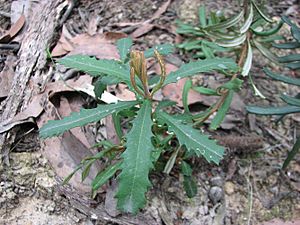
The way silver banksia reacts to fire depends on where it grows. In some areas, like the Gibraltar Range and Sydney, the plants are killed by fire. However, they store their seeds in old cones in the plant's canopy. These seeds are released after a bushfire, allowing new plants to grow. This is called being serotinous. Studies show that these seeds usually spread only short distances from the parent plant.
In other areas, like the Little Desert National Park in Victoria, the silver banksia grows as a low shrub that regrows from suckers after a fire. These plants don't seem to live longer than 25 years. After that, older plants die and are replaced by younger ones growing from suckers around them.
Tasmanian silver banksia plants can handle frost at any time of year. This might be why they have spread so well and grow in many different habitats across the island. This ability may have helped them survive cold periods long ago.
A study in Western Australia showed that the silver banksia is somewhat sensitive to a plant disease called Phytophthora cinnamomi dieback.
Uses of the Silver Banksia
Traditional Aboriginal Uses
Aboriginal people across eastern Australia used the silver banksia in many ways.
- The sweet nectar from the flowers was sucked directly or soaked in water to make a sweet drink. Sometimes, it was mixed with wattle gum to create a sweet treat.
- The wood was used to make needles.
- The dried flowers were used to strain water for drinking.
Timber Use
The wood of the silver banksia has a reddish color and is soft. It's sometimes used for woodturning, but it needs to be dried carefully to prevent it from bending or twisting.
Growing Silver Banksia in Gardens
The silver banksia was first grown in England in 1802. It was planted in famous gardens like Kew and Cambridge Botanic Gardens. One plant at Kew grew into a tree 24 feet (7.3 m) tall with a trunk 60 centimetres (24 in) around by the time it was 40 years old.
In a garden, B. marginata is generally easy to grow. It prefers a sunny or partly-shaded spot with good drainage. If it's too shady, it might grow tall and thin, but in full sun, it will be a more compact, bushy shrub. Some types from drier areas don't do well in humid summers. The flowers are not very noticeable unless there are many of them. Once established, these plants can handle dry periods, coastal conditions, and cold temperatures down to −10 °C (14 °F).
You can grow new plants from seeds or from cuttings. Cuttings are important if you want to grow a plant with a specific shape, like a dwarf type. Some seeds from high-altitude areas need a cold period (called stratification) before they will sprout. This might be so that seeds released after a summer or autumn fire stay dormant through winter and sprout in spring.
Several dwarf forms of silver banksia are sold in nurseries. 'Mini Marg' is a small type from Tasmania that grows only 30 cm (12 in) high and 1 m (3.3 ft) wide. 'Mallacoota Dwarf' was chosen from a natural group of plants in Victoria. The silver banksia, including 'Mini Marg', is also used in bonsai, which is the art of growing miniature trees.
Images for kids
-
Plate titled Banksia marcescens in Description des plantes rares cultivées à Malmaison et à Navarre by Aimé Bonpland
-
Inflorescence part-way through anthesis, with the individual flowers at the base opened and those further up the spike still closed
-
A seedling growing in Wombat State Forest displays the serrated juvenile leaves which are larger and broader than adult ones.
See also
 In Spanish: Banksia plateada para niños
In Spanish: Banksia plateada para niños


